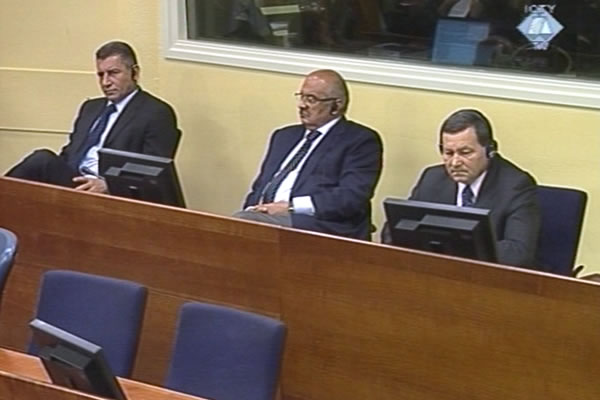Home
SHELLING WAS INDISCRIMINATE
Croatian Generals' Judgment (5)
The Trial Chamber found that the artillery attacks on the Krajina towns in Operation Storm were carried out in order to force the Serb civilians to flee, just as the prosecution claimed. The judges did not give any credence to the defense case, which was that the towns were shelled in order to achieve a military victory
 Ante Gotovina, Ivan Cermak and Mladen Markac in the courtroom
Ante Gotovina, Ivan Cermak and Mladen Markac in the courtroom In its judgment, the Trial Chamber sentenced the Croatian generals Ante Gotovina and Mladen Markac to 24 and 18 years in prison respectively and acquitted Ivan Cermak of all charges. The judges found that the Serb civilians were persecuted in Operation Storm through a campaign of indiscriminate shelling of the towns of Knin, Benkovac, Obrovac and Gracac. Judge Orie and the other two judges reached that conclusion after they compared the artillery reports of the Croatian Army (HV) and the impact sites on the ground, and after they analyzed the number of impacts and the way in which the artillery targeted the towns.
The Trial Chamber looked at an order issued by the Split Military District commander Ante Gotovina and his artillery commander Marko Rajcic of 2 august 1995, in which they “issued orders for the HV artillery to put the towns of Drvar, Knin, Benkovac, Obrovac, and Gračac under artillery fire”. Although the judges say in the judgment that the language in the order might lead to the conclusion that the entire towns were treated as targets, they took into account Rajcic's testimony in court. He said that the military targets in the towns had been predetermined, and that the order lists those locations as targets. When the judges took into account the HV reports from the field, they concluded that they could not find beyond reasonable doubt that those towns were treated as targets.
Analyzing the evidence on the shelling of Knin, to the effect that the strikes occurred in regular intervals, the Chamber took note of the evidence of military experts called by the prosecution and the defense respectively, Harry Konings and Geoffrey Corn. They both agreed that “this method of fire can, depending on the target and the intended effect, be used for a military purpose or to psychologically harass civilians”. The judgment therefore states that the method used to shell Knin is not sufficient to conclude that the attack on the town targeted civilians.
The fact that a large number of shells actually hit areas devoid of military targets led the judges to conclude nevertheless that Knin had been shelled indiscriminately. As the Chamber concluded, a total of 600 shells hit Knin on 4 August 1995, and 300 shells were fired the next day. The judgment notes that it was not possible to determine with any accuracy the exact impact sites for many shells, but the evidence shows that “a considerable” number [of those] hit civilians buildings or areas”. The distance of 200 meters was taken as a permissible margin of error in light of the accuracy of artillery pieces used by the HV and the range from which the shells were fired.
The Chamber accepted that the buildings in Knin, listed as artillery targets in some orders, e.g., the Krajina army main staff, the Northern Barracks, the Senjak Barracks, the police station, Milan Martic's apartment and the railway station, were in fact legitimate military targets. However, according to the evidence, a large number of shells hit areas 300 to 700 meters away from those targets. Thus, for instance, about 40 shells fell near the headquarters of the European monitoring mission in the town, which was 300 meters away from the nearest military target. Likewise, four shells exploded in the immediate vicinity of the Knin hospital, and at least one shell impacted near the cemetery, at a distance of 450 and 700 meters from military targets respectively. These are not the only examples listed in the judgment. The Chamber also considered that targeting Milan Martic's apartment downtown was indiscriminate and posed 'too great a risk for civilians. “This risk was excessive in relation to the anticipated military
Advantage”, the judges noted. This led the judges to conclude that the Croatian artillery 'deliberately fired on' civilian targets in Knin.
The Chamber drew similar conclusions about the shelling of Benkovac, Obrovac and Gracac; in fact, the only town where civilian targets were not shelled indiscriminately was Donji Lapac.
The Chamber notes that in light of what actually happened on the ground, Gotovina's order to use artillery to fire on Drvar, Knin, Benkovac, Obrovac and Gracac can indeed be interpreted as an order to treat entire towns as artillery targets, rather than to fire on predetermined military targets.
The judges concluded that the artillery fire on Knin, Benkovac, Obrovac and Gracac constituted 'an indiscriminate attack on these towns and thus an unlawful attack on civilians and civilian objects”. In light of the ethnic composition of the population in those towns, the judges concluded that the attacks were carried out “with the intention to discriminate [the population] on political, racial, or religious grounds.
Linked Reports
- Case : Gotovina et al. - "Operation Storm"
- 2011-04-21 ’LIMITED RESULTS’ OF INVESTIGATIONS INTO CRIMES AFTER OPERATION STORM
- 2011-04-20 DISCRIMINATORY LAWS AFTER THE OPERATION STORM
- 2011-04-19 TUDJMAN’S ATTITUDE TO SERBS
- 2011-04-29 DEPORTATION, NOT EVACUATION
- 2011-05-03 GOTOVINA’S CONTRIBUTION TO JOINT CRIMINAL ENTERPRISE
- 2011-05-06 MARKAC’S FAILURE TO ACT IN OPERATION STORM
